Search any question & find its solution
Question:
Answered & Verified by Expert
Consider a box with three terminals on top of it as shown in figure.

Three components namely, two germanium diodes and one resistor are connected across these three terminals in some arrangement.
A student performs an experiment in which any two of these three terminals are connected in the circuit shown in figure.
The student obtains graphs of current Voltage characteristics for unknown combination of components between the two terminals connected in the circuit. The graphs are
(i) When $\mathrm{A}$ is positive and $\mathrm{B}$ is negative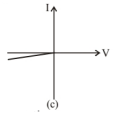
(ii) When $\mathrm{A}$ is negative and $\mathrm{B}$ is positive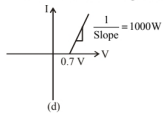
(iii) When $\mathrm{B}$ is negative and $\mathrm{C}$ is positive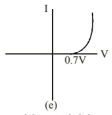
(iv) When $\mathrm{B}$ is positive and $\mathrm{C}$ is negative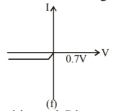
(v) When $\mathrm{A}$ is positive and $\mathrm{C}$ is negative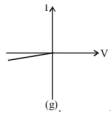
(vi) When $A$ is negative and $C$ is positive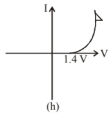
From these graphs of current - voltage characteristic shown in fig. (c) to (h) determine the arrangement of components between $\mathrm{A}, \mathrm{B}$ and $\mathrm{C}$.

Three components namely, two germanium diodes and one resistor are connected across these three terminals in some arrangement.
A student performs an experiment in which any two of these three terminals are connected in the circuit shown in figure.
The student obtains graphs of current Voltage characteristics for unknown combination of components between the two terminals connected in the circuit. The graphs are
(i) When $\mathrm{A}$ is positive and $\mathrm{B}$ is negative

(ii) When $\mathrm{A}$ is negative and $\mathrm{B}$ is positive

(iii) When $\mathrm{B}$ is negative and $\mathrm{C}$ is positive

(iv) When $\mathrm{B}$ is positive and $\mathrm{C}$ is negative

(v) When $\mathrm{A}$ is positive and $\mathrm{C}$ is negative

(vi) When $A$ is negative and $C$ is positive

From these graphs of current - voltage characteristic shown in fig. (c) to (h) determine the arrangement of components between $\mathrm{A}, \mathrm{B}$ and $\mathrm{C}$.
Solution:
2711 Upvotes
Verified Answer
(a) For condition (i) of graph shows a reverse characteristics is shown in fig. (c). Here $A$ is connected to $\mathrm{n}$ - side of $\mathrm{p}-\mathrm{n}$ junction $\mathrm{I}$ and $\mathrm{B}$ is connected to $\mathrm{p}-\mathrm{n}$ junction I with a resistance in series.

(b) For condition (ii) of graph shows a forward characteristics is shown in fig. (d), where $0.7 \mathrm{~V}$ is the knee voltage of $\mathrm{p}-\mathrm{n}$ junction $11 /$ slope $=(1 / 1000) \Omega$.
It means A is connected to $n-$ side of $p-n$ junction I and B is connected to $\mathrm{p}$-side of $\mathrm{p}-\mathrm{n}$ junction I and resistance $\mathrm{R}$ is in series of p-n junction I between A and B.
(c) For condition (iii) of graph shows a forward characteristics is shown in figure (e), where $0.7 \mathrm{~V}$ is knee voltage. In this case $\mathrm{p}-$ side of $\mathrm{p}-\mathrm{n}$ junction II is connected to $\mathrm{C}$ and $\mathrm{n}$-side of $\mathrm{p}-\mathrm{n}$ junction II to $\mathrm{B}$.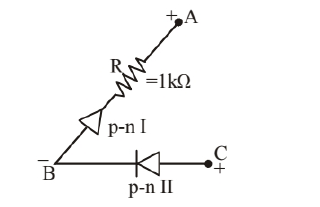
(d) For condition (iv) of graph shows reverse biased characteristic of $\mathrm{p}-\mathrm{n}$ junction II. $\mathrm{n}$ side with $\mathrm{B}$ and $\mathrm{P}$ side with c along with a resistance in series. So,
(e) Similarly condition (v) of graph shows reverse biased characteristics.
(f) For condition (vi) of graph shows forward biased characteristics of $\mathrm{p}-\mathrm{n}$ junction II So,

(b) For condition (ii) of graph shows a forward characteristics is shown in fig. (d), where $0.7 \mathrm{~V}$ is the knee voltage of $\mathrm{p}-\mathrm{n}$ junction $11 /$ slope $=(1 / 1000) \Omega$.
It means A is connected to $n-$ side of $p-n$ junction I and B is connected to $\mathrm{p}$-side of $\mathrm{p}-\mathrm{n}$ junction I and resistance $\mathrm{R}$ is in series of p-n junction I between A and B.

(c) For condition (iii) of graph shows a forward characteristics is shown in figure (e), where $0.7 \mathrm{~V}$ is knee voltage. In this case $\mathrm{p}-$ side of $\mathrm{p}-\mathrm{n}$ junction II is connected to $\mathrm{C}$ and $\mathrm{n}$-side of $\mathrm{p}-\mathrm{n}$ junction II to $\mathrm{B}$.

(d) For condition (iv) of graph shows reverse biased characteristic of $\mathrm{p}-\mathrm{n}$ junction II. $\mathrm{n}$ side with $\mathrm{B}$ and $\mathrm{P}$ side with c along with a resistance in series. So,

(e) Similarly condition (v) of graph shows reverse biased characteristics.

(f) For condition (vi) of graph shows forward biased characteristics of $\mathrm{p}-\mathrm{n}$ junction II So,

Looking for more such questions to practice?
Download the MARKS App - The ultimate prep app for IIT JEE & NEET with chapter-wise PYQs, revision notes, formula sheets, custom tests & much more.